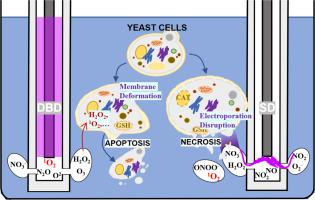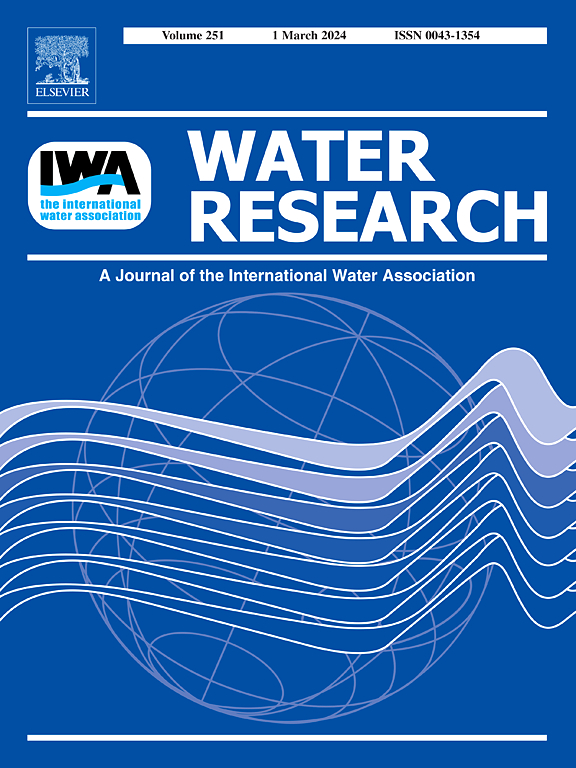Saccharomyces cerevisiae inactivation during water disinfection by underwater plasma bubbles: preferential reactive species production and subcellular mechanisms
IF 11.4
1区 环境科学与生态学
Q1 ENGINEERING, ENVIRONMENTAL
引用次数: 0
Abstract
The escalating challenges posed by water resource contamination, especially exacerbated by health concerns associated with microbial fungi threats, necessitate advanced disinfection technologies. Within this context, non-thermal plasma (NTP) generated within bubble column reactors emerges as a promising antifungal strategy. The effects of direct plasma bubbles within different discharge modes and thus-produced plasma activated water (PAW) on the inactivation of Saccharomyces cerevisiae are investigated. Results show that plasma bubbles generated by dielectric barrier discharge (DBD) mode can effectively inactivate yeast cells (∼4.4 logs reduction) within 1 min, outperforming the spark discharge (SD). In this case, SD can cause a significant portion of cell necrosis, possibly due to the high electric field at the bubble interface. In PAW, DBD and SD produce different dominant long-lived oxygen and nitrogen species, while the crucial short-lived species in yeast apoptosis are both attributed to the singlet oxygen (1O2) as confirmed by scavenger testing. The detection of intracellular reactive oxygen species and antioxidant enzymes further illustrates the role of PAW in causing apoptosis. Overall, this study demonstrates the discharge mode-dependent modulation of reactive chemistry in plasma-liquid interactions and provides new insights into the subcellular mechanism of plasma-enabled yeast inactivation for water resource decontamination.

水下等离子体气泡对水消毒过程中酿酒酵母的失活:优先反应种的产生和亚细胞机制
水资源污染带来的挑战不断升级,特别是与微生物真菌威胁有关的健康问题加剧了这一挑战,因此需要先进的消毒技术。在这种情况下,气泡柱反应器内产生的非热等离子体(NTP)成为一种有前途的抗真菌策略。研究了不同放电方式下直接等离子体气泡及其产生的等离子体活性水(PAW)对酿酒酵母灭活的影响。结果表明,介质阻挡放电(DBD)模式产生的等离子体气泡可在1 min内有效灭活酵母细胞(减少约4.4 log),优于火花放电(SD)模式。在这种情况下,SD可引起很大一部分细胞坏死,可能是由于气泡界面处的高电场。在PAW中,DBD和SD产生不同的优势长寿命氧和氮物种,而酵母凋亡中关键的短寿命物种均归因于单重态氧(1O2),经清道夫测试证实。细胞内活性氧和抗氧化酶的检测进一步说明了PAW在细胞凋亡中的作用。总的来说,这项研究证明了等离子体-液体相互作用中反应化学的放电模式依赖性调节,并为等离子体激活酵母灭活用于水资源净化的亚细胞机制提供了新的见解。
本文章由计算机程序翻译,如有差异,请以英文原文为准。
求助全文
约1分钟内获得全文
求助全文
来源期刊

Water Research
环境科学-工程:环境
CiteScore
20.80
自引率
9.40%
发文量
1307
审稿时长
38 days
期刊介绍:
Water Research, along with its open access companion journal Water Research X, serves as a platform for publishing original research papers covering various aspects of the science and technology related to the anthropogenic water cycle, water quality, and its management worldwide. The audience targeted by the journal comprises biologists, chemical engineers, chemists, civil engineers, environmental engineers, limnologists, and microbiologists. The scope of the journal include:
•Treatment processes for water and wastewaters (municipal, agricultural, industrial, and on-site treatment), including resource recovery and residuals management;
•Urban hydrology including sewer systems, stormwater management, and green infrastructure;
•Drinking water treatment and distribution;
•Potable and non-potable water reuse;
•Sanitation, public health, and risk assessment;
•Anaerobic digestion, solid and hazardous waste management, including source characterization and the effects and control of leachates and gaseous emissions;
•Contaminants (chemical, microbial, anthropogenic particles such as nanoparticles or microplastics) and related water quality sensing, monitoring, fate, and assessment;
•Anthropogenic impacts on inland, tidal, coastal and urban waters, focusing on surface and ground waters, and point and non-point sources of pollution;
•Environmental restoration, linked to surface water, groundwater and groundwater remediation;
•Analysis of the interfaces between sediments and water, and between water and atmosphere, focusing specifically on anthropogenic impacts;
•Mathematical modelling, systems analysis, machine learning, and beneficial use of big data related to the anthropogenic water cycle;
•Socio-economic, policy, and regulations studies.
 求助内容:
求助内容: 应助结果提醒方式:
应助结果提醒方式:


